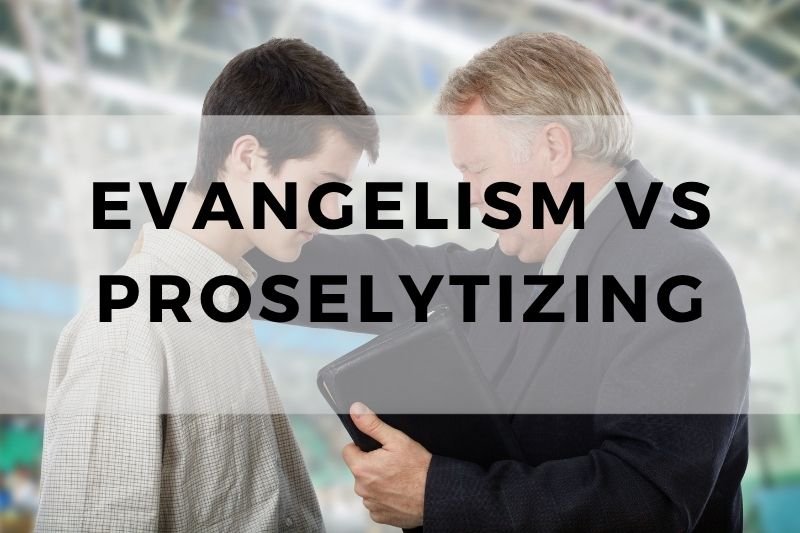
Evangelism and proselytizing are often used interchangeably, but they are not the same. Both involve sharing religious beliefs, but their methods and intentions differ. Understanding the distinction is important for anyone involved in faith-based outreach. Evangelism focuses on sharing the message of Christ with love and respect. Proselytizing is often linked to pressure and coercion. Confusing the two can harm relationships and hinder true witness. This article breaks down what each term means, how they compare, and why the difference matters. Knowing this can help believers share their faith with integrity and clarity.
Definitions
Understanding the terms “evangelism” and “proselytizing” begins with defining them clearly. Though they share some overlap, their meanings and implications differ.
Evangelism
Evangelism is the act of sharing the good news of Jesus Christ. It is rooted in the Bible, particularly in the Great Commission (Matthew 28:19-20). Evangelism involves presenting the message of salvation with honesty, humility, and love. It invites others to consider Christ without forcing a decision. The goal is not just conversion but a genuine relationship with God. Evangelism respects the listener’s freedom to respond. It often happens through conversations, testimonies, acts of kindness, and public preaching. Evangelism is guided by the Holy Spirit and centers on Jesus. It is a natural part of Christian life, not a forced campaign. At its core, evangelism is about pointing others to Christ and letting the Holy Spirit do the rest.
Proselytizing
Proselytizing is the attempt to convert someone to a different belief system, often through pressure or argument. While it can include religious discussion, it is usually marked by aggressive or persuasive tactics. The focus is more on winning the person over than building a relationship. Proselytizing can sometimes ignore the person’s background, questions, or objections. In some contexts, it carries a negative connotation, implying disrespect or manipulation. It may involve guilt, fear, or debate instead of love and grace. Proselytizing is more about achieving a result—getting someone to switch beliefs—than about sharing life-changing truth. It can damage trust and give religion a bad name. Unlike evangelism, it often lacks sensitivity to timing and context.
Evangelism Vs Proselytizing: Key Differences
Evangelism and proselytizing may look similar on the surface, but their approaches and values differ in important ways. Below are the key differences that set them apart.
#1. Voluntary vs Forced Approach
Evangelism invites. Proselytizing pressures. Evangelism respects a person’s right to say no. It presents the message and lets the listener decide. There is no manipulation. The choice is left to the individual. In contrast, proselytizing often pushes for agreement. It can apply social, emotional, or even moral pressure to get a response. This forced approach can create resistance or resentment. Evangelism trusts that God works in hearts without pressure. Proselytizing tries to control the outcome. This difference affects how the message is received and how the speaker is perceived. People are more open to a message when it is offered, not forced.
#2. Respectful Sharing vs Aggressive Persuasion
Evangelism is a conversation. Proselytizing is often a debate. Evangelism listens as much as it speaks. It values the other person’s beliefs and experiences. It seeks to share the truth with gentleness and respect. Aggressive persuasion, as seen in proselytizing, often ignores what the other person thinks. It focuses only on changing their mind. It may involve arguing, interrupting, or dismissing the other’s views. This can make people defensive. Evangelism builds trust through patience and love. Proselytizing risks burning bridges. The tone and manner of communication reveal the heart behind the message. Respect opens doors; aggression closes them.
#3. Relationship-Building vs Pressure Tactics
Evangelism takes time. It invests in people. It builds relationships before talking about faith. The goal is to connect, understand, and care. Through that relationship, the message of Christ is shared. Proselytizing, on the other hand, often skips the relationship. It jumps straight to conversion. It may treat people as targets, not individuals. Pressure tactics—like guilt or fear—can be used to push decisions. These tactics can damage trust and make people walk away. Evangelism waits for the right moment. Proselytizing forces the moment. One is led by care for the person; the other is driven by results.
#4. Christ-Centered Message vs Conversion Focus
Evangelism points to Christ. It focuses on who Jesus is, what He has done, and why that matters. The message is centered on the gospel. It is not just about changing someone’s religion. It is about inviting them into a relationship with Christ. Proselytizing focuses on conversion as the goal. The message may center more on changing beliefs or joining a group. Christ may be mentioned, but the focus is on the outcome. This shift in focus can lead to shallow or forced decisions. Evangelism trusts in the power of the gospel. Proselytizing trusts in technique.
#5. Spirit-Led vs Strategy-Driven
Evangelism depends on the Holy Spirit. It seeks wisdom, timing, and guidance from God. The evangelist prays, listens, and moves when prompted. It is not driven by a script or checklist. Proselytizing is often led by human strategy. It may rely on arguments, formulas, or sales-like methods. The emphasis is on control and planning. Evangelism allows space for God to work in unseen ways. Proselytizing often forces a decision through pressure. The Spirit-led approach brings peace and patience. Strategy-driven methods can feel rushed and rigid. One depends on God; the other leans on human effort.
#6. Respect for Beliefs vs Dismissal of Beliefs
Evangelism acknowledges the listener’s beliefs. It does not mock or belittle them. Even when it disagrees, it shows respect. This respect opens the door for honest conversation. Proselytizing often dismisses the other’s faith as wrong or foolish. It may not give space for dialogue. This approach can make people feel attacked or judged. Evangelism values the person behind the belief. Proselytizing sees the belief as a barrier to remove. When beliefs are dismissed, trust is broken. When they are respected, people are more willing to listen. Respect builds a bridge; dismissal builds a wall.
Similarities Between Evangelism and Proselytizing
While evangelism and proselytizing differ in approach and tone, they also share several similarities. These common features often cause the two to be confused.
#1. Goal of Spreading Beliefs
Both evangelism and proselytizing aim to spread religious beliefs. The person sharing wants others to embrace a new faith or way of thinking. The core desire is to see a change in what someone believes. Whether done gently or forcefully, the end goal remains the same: sharing truth as the speaker understands it. This desire to spread faith is not wrong in itself. What matters is how it’s done. Evangelism shares out of love and trust in God. Proselytizing may push for results. But both aim to communicate a message that can change lives.
#2. Use of Verbal Communication
Both methods rely heavily on speaking. Whether through one-on-one talks, sermons, or public preaching, words are central. The goal is to explain, persuade, and invite. The difference lies in tone and intent, not the use of speech. Evangelism uses words to witness and testify. Proselytizing uses words to convince or argue. Both require communication skills and clarity of message. Verbal sharing is a powerful tool in spreading belief. It allows for personal interaction and explanation. The message must be spoken for others to hear and consider. In both approaches, what is said—and how it is said—matters deeply.
#3. Desire for Conversion
Evangelists and proselytizers both want others to change their beliefs. They hope the listener will accept what is being shared. This desire comes from a deep conviction that their message is true. The difference lies in how that change is encouraged. Evangelism allows space for the Holy Spirit to work. It trusts that true conversion cannot be forced. Proselytizing, by contrast, may attempt to produce quick results. But both approaches are motivated by a belief that conversion is possible and necessary. This shared goal is part of why the two are often confused. The key is not the desire itself but the method used to pursue it.
#4. Religious Motivation
Both evangelism and proselytizing are driven by religious belief. The person sharing is motivated by faith and a sense of duty. For Christians, evangelism flows from obedience to Christ’s command. Proselytizing may also come from religious zeal. In both cases, the person believes that sharing their faith matters. They see it as an act of spiritual importance. This motivation can lead to great courage and persistence. But it also requires care and wisdom. Strong belief can inspire, but it can also overwhelm if not expressed with love. Both methods come from religious conviction, but that conviction must be guided by respect and truth.
#5. Outreach-Oriented Approach
Both evangelism and proselytizing involve reaching out. They are not passive. They seek to go beyond personal belief and engage others. This outreach can take many forms: conversations, events, literature, or media. The shared value is action—stepping out to share faith with others. Evangelism does this through relational and Spirit-led means. Proselytizing may use more structured or aggressive outreach. But both reflect a desire to spread truth beyond the self. Outreach is essential to spreading any belief. What separates effective outreach from harmful pressure is the method and mindset behind it. Both evangelism and proselytizing are active expressions of faith.
Closing Thoughts
Evangelism and proselytizing both seek to share faith, but the heart behind each is different. Evangelism is rooted in love, respect, and a desire to see others know Christ through genuine, Spirit-led encounters. Proselytizing often relies on pressure and persuasion, which can harm relationships and damage the message. Understanding the difference helps Christians share their faith more effectively and with integrity. The goal is not just to win arguments or gain converts but to point people to the truth of the gospel. When faith is shared with humility and grace, it reflects the character of Christ.
